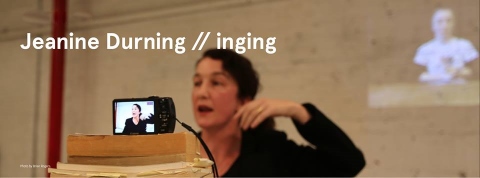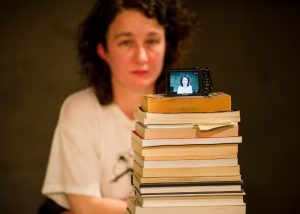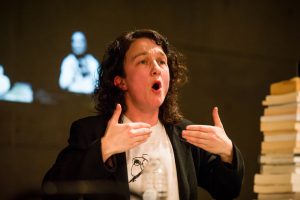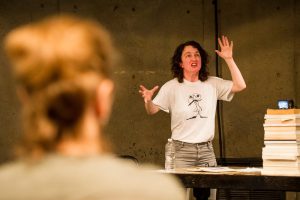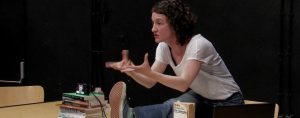GERUNDING
Multiple monitors flash images of choreographer and performer Jeanine Durning’s face as she filters through emotions of delight, amusement and pensiveness in the small, private Automata Theater in L.A.’s Chinatown. After pacing endlessly around the studio, Durning—maneuvering through narrow gaps between the audience’s scattered folding chairs—starts talking about the building’s exit and entrance. After this information, she jumps from topic to topic, making pop culture references and using observational humor to point out both similarities and inconsistencies in word meanings as a way of clarifying herself to the spectators. As the show progresses, her remarks grow more personal, and she draws her viewers further into her phrases, which flow endlessly in circular thoughts that are introspective, fascinating and easily relatable.
This is inging, a torrent of words that shows how language is used to connect with others and to find a place in this ever-shifting world, one that shapes the way we see ourselves and vice versa.
She grounds her linguistic dance within the theater’s layout, improvising her speech as she follows a train of thought based on her surroundings. From there she branches out to broader topics about social and personal issues, sometimes linking these thoughts with philosophical questions and often with popular movie lines or song refrains, which she sings or recites in character. “This is not professional,” she utters, a reminder that her work is an examination of a person’s mind when it is presented with no filter.
Durning hooks you into her speech almost immediately. Although the talking is one-sided, she frames it like a conversation by making eye contact with audience members and occasionally directing questions to one person, cinching the idea that this night will never be repeated. Certain phrases resonate because they are abruptly mentioned after a slew of vocabulary-based jokes or funny quotes that are reminiscent of a conversation one might have with friends. The laughter subsides when Durning mentions some personal memories—her mother’s strong powdered smells or her complicated relationship with the Catholic-school nuns who preferred she be uncomfortable before being herself.
The discomfort continues as she talks about social issues, including the privilege she knows because she is not a person of color, and the unsteady place we find ourselves in globally given the current president and the distress caused by the sociopolitical climate. Her decision not to mention Trump by name is self-consciously brought up in a thread she unravels about censorship, a concept her performance seems keen on.
She analyzes in a heady way: she describes “comfort” as an envelopment; as if it were onomatopoeia by association (even though it doesn’t technically fit that word’s definition). Emblematic of her emphatic delivery, she also repeats things in threes, sometimes stomping her foot to create a greater sense of rhythm.
Spacing is also very important to Durning, both physically and metaphorically. While moving around the theater, she stretches and gestures in ways that emphasize her words and reveal her thought process. Pointed fingers, open palms and reaching arms echo her mental journey as she organizes her subjects by pantomime, sorting them in the air while vocally formalizing each thought. “It’s good to have things in their place,” Durning adds as she rearranges the few books and props on her desk, which she occasionally uses as aids.
Although she never stops, she embraces pauses and what they stand for. Moments during which she gets stuck are filled with loud repetitions of a word: She pushes herself to continue with “THE, THE, THE…” It reminds us that the show is improvised, which makes its 50-minute run that much more impressive. It is fascinating to watch human thought lose itself in loops of analysis when struggling to become concrete.
As Durning’s adventure becomes more metaphysical, her actions begin to come off as neurotic. Her speech is peppered with false starts and short gasps that continue the sentence’s rhythm, but indicate she may be reaching a limit both in her ability to speak nonstop and her sanity. She travels throughout the room as her movements become erratic, exaggerating her stretches and leg extensions as she further explores her physical presence within the theater and the monologue. Audience members can see each other’s faces, which change as Durning stutters and unwinds. It looked as though a few viewers were about to cry when she talked about the feeling of not having a body while forcing herself to continue.
When she discusses giving vs. receiving, she lies on the floor, talking faster until the climax, when she yells “TAKE IT. TAKE. TAAAKKKE” several times before placing her face against the wall and concluding with a deafening, unnerving silence.
There are a great many things to take from this non-stop force, who clearly mutates her discourse from show to show. At last weekend’s performance, I saw that we are indeed both takers and givers, balancing generosity towards others with their perception of us, all the while dealing with our internal crises. It takes doing, acting, being, knowing and living in the present.
previous production photos by Ian Douglas, Brian Waters, and Soo VAC
Jeanine Durning’s inging
presented by Los Angeles Performance Practice
Automata, 504 Chung King Court in Chinatown
played May 12 – 14, 2017
for for more info, visit LAPP and Jeanine Durning
